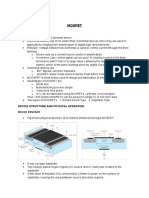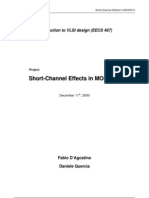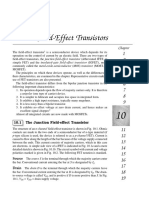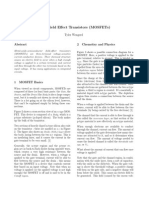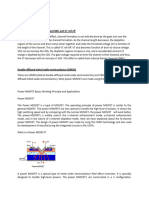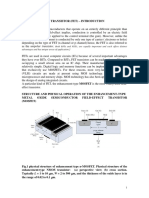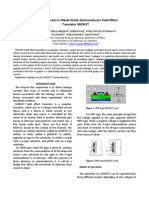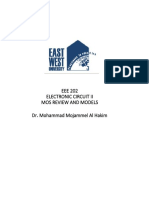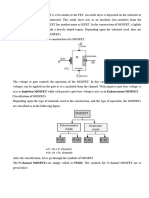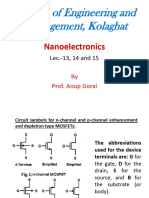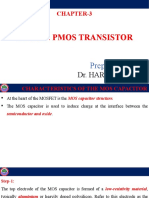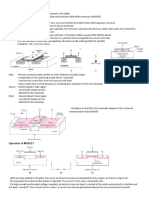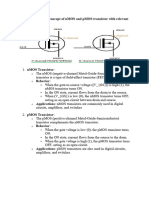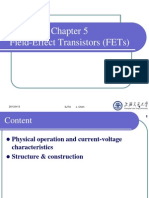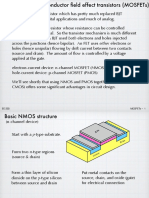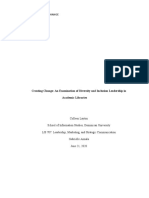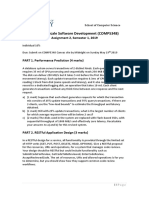Lect13 Mosfet
Lect13 Mosfet
Uploaded by
Abhay ChaudharyCopyright:
Available Formats
Lect13 Mosfet
Lect13 Mosfet
Uploaded by
Abhay ChaudharyOriginal Description:
Copyright
Available Formats
Share this document
Did you find this document useful?
Is this content inappropriate?
Copyright:
Available Formats
Lect13 Mosfet
Lect13 Mosfet
Uploaded by
Abhay ChaudharyCopyright:
Available Formats
1
Lecture-13
Metal Oxide Semiconductor FET (MOSFET)
Introduction: Metal-oxide-semiconductor eld-eect transistors (MOSFETs) have
played a major role in the development of complex large scale integrated circuits.
In particular, they have provided the basis for most large scale integrated digi-
tal circuits. The MOSFET operation depends on the conductance modulation of
the channel of carriers that are induced by an applied gate voltage. Modulation
is achieved by the variation in the carrier surface density. In the JFET on the
other hand, conductance modulation is accomplished by the variation of the cross-
sectional area of the channel formed from the pn junction. FETs are also known as
unipolar devices because conduction is by means of one type of carrier only. One
very important application of MOSFETS is in the arrangement known as a comple-
mentary metal oxide semiconductor system (CMOS). The CMOS forms, at present,
the mainstream of high density digital system design technology.
There are two types of MOS transistors. The depletion MOSFET has a behavior
similar to that of the JFET; at zero voltage and a xed drain voltage, the current
is a maximum and then decreases with the applied gate potential as in Fig.6 of
LN-11. The second kind of device, called the enhancement MOSFET, exhibits no
current at zero gate voltage and the magnitude of the output current increases with
an increase in the magnitude of the gate potential. Both types can exist in either
the p-channel or n-channel variety. We consider the characteristics of an n-channel
for the subsequent discussions.
S
(metal)
D
Drain
ntype regions
Source
Gate
G
ptype substrate
L
ntype substrate
S
(metal)
D
Drain
Source
Gate
G
L
ptype regions
Silicon dioxide
(SiO)
2
(a) (b)
Figure 1: Enhancement (MOSFET) structures: (a) n-channel; (b) p-channel
The Enhancement MOS Structure: A simplied form of the structure of an
n-channel enhancement MOSFET is shown in the Fig.1(a) and that for a p-channel
device, in the Fig.1(b). The devices depicted in the Fig.1 are commonly referred
2
to as NMOS and PMOS transistors. As indicated in the Fig.1(a), the two n-
type regions embedded in the p-type substrate (the body) are the source and drain
electrodes. The region between source and drain is the channel, which is covered
by the thin silicon dioxide (SiO
2
) layer. The gate is formed by the metal electrode
played over the oxide layer. At present, MOSFET fabrication technology utilizes a
polysilicon
1
conducting layer for the gate rather than the metal gate displayed in
the Fig.1. The physical principles which govern MOSFET operation, however, are
the same for both types of the gate.
The metal are of the gate, in conjunction with the insulating dielectric oxide layer
and the semiconductor channel, form a parallel-plate capacitor. The insulating
layer of the silicon dioxide is the reason why this device is also called the insulated-
gate eld-eect transistor (IGFET). This layer results in an extremely high input
resistance (10
10
to 10
15
) for the MOSFET.
Physical Behavior of the Enhancement MOSFET: In the Fig.2(a) we
show an NMOS transistor in which the source and substrate are grounded and
the drain-to-source voltage V
DS
is set to zero. The positive voltage applied to the
gate establishes an electric eld which is directly perpendicularly through the oxide.
This eld will end on induced negative charges near the semiconductor surface,
as shown in the Fig.2(a). Since the p-type substrate contains very few electrons,
the positive surface charges are primarily electrons obtained from the n-type source-
to-drain. These mobile negative charges, which are minority carriers in the p-type
substrate, form an inversion layer. Such an inversion layer is formed only if V
GS
exceeds a threshold voltage V
T
.
2
The induced chargers beneath the oxide constitute
an n-channel. As the voltage on the gate increases beyond V
T
, the number of induced
negative charges in the semiconductor increases. Consequently, the conductivity of
the channel increases. Application of a positive potential between the drain and
source produces a current in the induced channel between drain and source. Thus
the drain current is enhanced by the positive gate voltage and the device is called
enhancement-type MOSFET.
Let us consider the situation where V
DS
is increased from zero with V
GS
maintained
at a constant positive value greater than V
T
(that is, V
GS
V
T
> 0). For small values
of V
DS
(V
DS
< V
GS
V
T
), an increase in V
DS
is accompanied by an increase in drain
current I
D
. The behavior of the MOSFET is that of resistance, and this region is
referred to as the ohmic region. As V
DS
increases, the drop across the gate oxide at
the drain side of the channel V
GD
= V
DS
V
GS
decreases. This reduced potential
dierence lowers the eld across the drain end of the dielectric, which results in
1
Polysilicon refers to doped silicon in which the individual parts of the crystalline structure are
randomly oriented in space. The behavior of polysilicon is similar that of a metal
2
In this topic the threshold voltage should not be confused with the volt-equivalent of
temperature
3
fewer inversion charges in this region portion of induced channel. The channel is
being pinched o, and I
D
increases much more slowly with respect to increases in
V
DS
than in the ohmic region near the origin. Ideally once pinch-o is achieved, a
further increase in V
DS
produces no change in I
D
and current saturation exists. This
saturation region is similar in nature to velocity saturation in the JFET. The value
of I
D
attained in saturation depends on the value of V
GS
. Increases in V
GS
> V
T
result in increasing saturation values of I
D
.
Silicon dioxide
(SiO)
2
D
ntype regions
ptype substrate
G(+)
S
D
ntype regions
ptype substrate
G(+)
S
n n n n
(+)
(a) (b)
Figure 2: Biased NMOS enhancement transistor showing induced channel with (a)
V
DS
= 0 and (b) V
DS
> 0
D
r
a
i
n
c
u
r
r
e
n
t
I
A
D
50
150
200
250
300
100
1 2 3 4 5 6
DraintoSource Voltage V
Ohmic Region Saturation Region
V
GS
= 2 V
, V
DS
Figure 3: Enhancement NMOS output characteristics
The Enhancement MOSFET Volt-Ampere Characteristics: Manufactur-
ers of IC MOS transistors do nor provide curves of the volt-ampere characteristics.
If needed or desired, these curves are generated from the analytical expressions for
MOSFET behavior in each region of operation.
Analytical Expressions for the volt-ampere characteristics: An inversion
channel exists between source and drain, with V
DS
= 0, only if V
GS
> V
T
. For
4
V
GS
< V
T
, there are no mobile carriers at the drain end of the channel and I
D
= 0.
Thus V
T
is analogous to the pinch-o voltage in a JFET. The condition that
V
GS
< V
T
and I
D
= 0 signies that the MOSFET is a cut o and corresponds
to an open switch.
1. Ohmic Region: As described in the previous section, for V
GS
> V
T
, the chan-
nel conductivity is controlled by V
DS
in the ohmic also called nonsaturation or
triode region. More precisely, the ohmic region is dened by V
GS
V
T
> V
DS
(or V
GD
= V
GS
V
DS
> V
T
). Theoretical analysis
3
of the ohmic region leads
to the result that the drain characteristic is given by
I
D
= k
W
L
[2(V
GS
V
T
)V
DS
V
2
DS
] (1)
where L is the channel length, W the channel width (perpendicular to L) and
k is the process parameter in A/V
2
. The process parameter k =
n
C
o
/2,
where
n
is the electron mobility and C
o
is the gate capacitance per unit area
(and equals /T
ox
, the ratio of permittivity and thickness of the oxide layer).
Of note is that V
T
also depends on C
o
as well as the doping densities of the
n-type drain and source and p-substrate.
2. Saturation Region: Ideally, I
D
is constant and independent of V
DS
in the
saturation region for which V
GS
V
T
< V
DS
(but greater than zero). The value
of I
D
depends only on the eective control voltage V
GS
V
T
as given below,
I
D
= k
W
L
(V
GS
V
T
)
2
I
DS
(2)
where the subscript S added to I
D
denotes that the drain current in the
saturation region is under consideration. The dividing line between the ohmic
region and saturation regions is given by V
GS
V
T
= V
DS
. Substitution of this
value of V
DS
in Eqn.(1) results in Eqn.(2). The dashed curve in Fig.3, which
indicates that boundary between the ohmic and saturation regions, is given
by
I
D
k
W
L
V
2
DS
(3)
Several observations concerning the expressions in the Eqn.(1) and (2) are notewor-
thy. First, the aspect ratio W/L is an important parameter as it serves as a scale
factor for the drain current. Thus two (or more) MOSFETs having the same value
of V
T
but with dierent current capabilities can be fabricated on the same chip by
3
Derivation of these expressions will be done in the later lectures
5
using two (or more) dierent values of W/L. Second, the parameter k has typical
values which lie in the range of 10 to 50 A/V
2
in present commercial NMOS pro-
cesses. Consequently high values of I
D
(several milliamperes) are obtainable only in
devices with high W/L ratio that is devices which consume a large area.
The MOSFET transfer characteristic is plot of I
D
versus V
GS
at constant V
DS
in the
saturation region. The curve in Fig.4 is the transfer characteristic for the MOSFET
given in Fig.3
D
r
a
i
n
C
u
r
r
e
n
t
I
D
A
T
V
1 2 3 4 5 6
300
250
200
150
100
GatetoSource voltage V
GS
, V
Figure 4: Transfer Characteristics of NMOS enhancement transistor in Fig.3
The volt-ampere characteristics in the Fig.3 are for an ideal MOSFET. in reality,
I
D
increases slightly with V
DS
in saturation region. The cause of this channel-
length modulation, an eect analogous to the base-width modulation in the BJT.
As shown in the Fig.5, if actual characteristics are extended back into the second
quadrant, they all meet at V
DS
= 1/. Because of the similarity with Early eect
in BJTs, the quantity 1/ is also referred to as the Early Eect. Typical values of
are in the range of 0.01 to 0.03 V
1
. To account for the channel-length modulation,
Eqn.(2) is modied by the factor (1 +V
DS
) as given by,
I
D
= k
W
L
(V
GS
V
T
)
2
(1 +V
DS
) (4)
The eect of the term 1 + V
DS
is usually negligible in digital circuits but can be
important in analog circuits.
Comparison of PMOS and NMOS Transistors: Historically p-channel en-
hancement transistors were used rst in MOS system because they were more easily
produced with greater yields and reliability than n-channel devices. Improvement
in fabrication methods have led to the dominance of NMOS transistors. The rea-
sons for this is described as, the hole mobility in silicon at normal led intensities is
about 500 cm
2
/(V.s). Thus, for devices having the same dimensions (1) the current
in the PMOS transistor is less than half of that in an NMOS device and (2) the
6
I
D
V
DS
V
GS
1/
Figure 5: Extension of output characteristics of NMOS transistor showing eect of
channel-length modulation
ON resistance of a p-channel MOSFET is nearly three times that for an n-channel
MOSFET. Alternatively, to achieve the same values of current and ON resistance
as in an NMOS transistor, the W/L ration of an PMOS device must be increased
to account for the lower hole mobility. This results in the PMS devices requiring
nearly three times the area of an equivalent NMOS transistor. Thus NMOS circuits
are smaller than PMOS circuits of the same complexity. The higher packaging den-
sity of the n-channel MOS also makes it faster in switching applications due to the
smaller junction areas. For all the reasons stated in this paragraph, NMOS devices
are used almost exclusively.
The Depletion MOSFET: A second type of MOS transistor can be made
if, between the n-type regions for drain and source, a narrow n channel is embed-
ded into the substrate. Let us consider the operation of such n-channel structure
as shown in the Fig.6. The minus signs in the Fig.6 are intended to indicate free
electrons in the channel near the interface with the oxide layer. With V
DS
= 0,
negative gate voltage induces positive charge into the channel. The recombination
of induced positive charge with the existing negative charge in the channel causes
a depletion of majority carriers. this action accounts for the designation depletion
MOSFET. If the gate voltage is made more negative, majority carriers can be vir-
tually depleted, and in eect, the channel is eliminated. Under these circumstances,
the drain current is zero. The least negative value of V
GS
for which the channel
is depleted of majority carriers is called the threshold voltage V
T
(analogous to the
pinch-o voltage in a JFET).
With V
GS
= 0, application of a positive V
DS
produces an appreciable drain cur-
rent denoted by I
DSS
. As V
GS
decreases toward the threshold, the drain current
decreases. At xed V
GS
, increasing values of V
DS
cause the drain current to saturate
as the channel becomes pinched o. The reasons for this are similar to the causes of
saturation in enhancement devices. Note in the Fig.6(b) that because of the voltage
7
Silicon dioxide
(SiO)
2
n n
(+)
(a) (b)
D
ntype regions
ptype substrate
S
ntype regions
ptype substrate
S
G
D(+)
G()
n channel
n
+ + +
n
+
B
Figure 6: Structure of an n-channel depletion-mode MOSFET with (a) V
GS
= 0 and
(b) V
T
< V
GS
< 0
drop along the channel due to I
D
, the region of the channel nearest the drain is
depleted more than is the region in the vicinity of the source. this phenomenon is
analogous to pinch-o occurring in a JFET at the drain end of the channel.
D
r
a
i
n
c
u
r
r
e
n
t
I
A
D
DraintoSource Voltage V , V
DS
50
150
200
250
300
100
1 2 3 4 5 6
V
GS
=+2.0
+1.5
+1.0
+0.5
0
0.5
1.0
Enhancement
Depletion
Figure 7: Output Characteristics of an NMOS transistor
A MOSFET of the type just described may also be operated in an enhancement
mode. It is only necessary to apply a positive gate voltage so that negative charges
are induced into the n-type channel. The additional negative charges induced into
the channel (enhances) the number of majority carriers already present. Thus,
for positive V
GS
, the drain current I
D
is greater than I
DSS
. The transfer function
for this device at V
DS
= 5 V is depicted in Fig.8.
MOSFET Circuit Symbols: Four commonly used circuit symbols for n-
channel MOSFETs are depicted in Fig.9. the symbols in Figs.9(a) and Fig.9(b)
can be used either for enhancement or depletion devices. The circuit symbol in
Fig.9(c) is used only for the enhancement-mode device. If the body, or substrate
8
D
r
a
i
n
C
u
r
r
e
n
t
I
D
A
T
V
1 2 3 4 5 6
300
250
200
150
100
GatetoSource voltage V
GS
, V
50
3 2 1
I
DSS
Enhancement
Depletion
Figure 8: Transfer Characteristics of an NMOS transistor
connection is not indicated, it is assumed that the substrate is either connected to
the source terminal or that B is tied to the most negative potential. this connec-
tion reverse-biases the pn junctions formed by the drain and source regions and
the substrate. Where both enhancement and depletion devices are employed in the
same circuit, we distinguish depletion MOSFETs by the use of the symbol given
in Fig.9(d). Most often we use Fig.9(b) as the n-channel MOSFET circuit symbol
with standard substrate connections implied.
The positive sense of all terminal currents is into the device. Thus, for an n-channel
MOSFET, I
D
is positive and I
S
is negative. Since I
G
= 0, I
D
= I
S
. The voltage drop
between drain and source is designated by V
DS
; V
GS
is used to indicate the voltage
drop from gate-to-source. Both quantities are positive for n-channel enhancement
MOSFETs. Depletion-mode operation requires negative values of V
GS
and positive
values of V
DS
.
For p-channel MOSFETs, the circuit symbols shown in the Fig.9 are used with
direction of the arrow reversed.
G
D
S
+
V
DS
+
V
GS
D
B
S
G
D
S
G
Drain (D)
B
Substrate
G
S (Source)
Gate
(a)
(c)
(d)
(b)
Figure 9: Circuit Symbols for an NMOS transistor
You might also like
- SpectraDocument52 pagesSpectraIftikhar GadarNo ratings yet
- Chapter 3 Metal Oxide Semiconductor (MOS)Document64 pagesChapter 3 Metal Oxide Semiconductor (MOS)Jay Chandra Dhar100% (1)
- HMC ScannerDocument12 pagesHMC ScannerHusseinMohamedHassanNo ratings yet
- Air Asia Marketing MixDocument8 pagesAir Asia Marketing MixAnonymous B6yEOYI50% (2)
- Variant Perception Understanding-VolatilityDocument20 pagesVariant Perception Understanding-VolatilityLinda FreemanNo ratings yet
- Metal Oxide Semiconductor TransistorsDocument39 pagesMetal Oxide Semiconductor TransistorsK MukundNo ratings yet
- Power Mosfets: Introduction To Fet'SDocument21 pagesPower Mosfets: Introduction To Fet'SSharth KumarNo ratings yet
- Mosfet: Device StructureDocument15 pagesMosfet: Device StructureNoorullah ShariffNo ratings yet
- Vlsi Design: Mos TransistorDocument162 pagesVlsi Design: Mos TransistorBasheer V.PNo ratings yet
- Mosfet Notes 1Document9 pagesMosfet Notes 1Anil SaiNo ratings yet
- Field Effect Transistor, Ujt, SCR, Triac: Scope of The ChapterDocument8 pagesField Effect Transistor, Ujt, SCR, Triac: Scope of The ChapterAkhilesh PandeNo ratings yet
- Short Channel EffectsDocument15 pagesShort Channel Effectsgene_palencia100% (1)
- ADC Unit 2 LM MOSFET BJTDocument37 pagesADC Unit 2 LM MOSFET BJTKeerthi SadhanaNo ratings yet
- Electronics Ch5Document30 pagesElectronics Ch5Santi Navarro MoralNo ratings yet
- V. Mosfet PDFDocument33 pagesV. Mosfet PDFleeminho_janxiNo ratings yet
- Analog & Digital Electronics: Course No: Ph-218 Lec-26: Metal Oxide Field Effect Transistors (Mosfets)Document16 pagesAnalog & Digital Electronics: Course No: Ph-218 Lec-26: Metal Oxide Field Effect Transistors (Mosfets)Udai SinghNo ratings yet
- PH3007 Logic Families L 29 - 31Document33 pagesPH3007 Logic Families L 29 - 31Nethmi LokusuriyaNo ratings yet
- Metal Oxide Semiconductor Field Effect Transisitor AssignmentDocument20 pagesMetal Oxide Semiconductor Field Effect Transisitor AssignmentSokoine Hamad DenisNo ratings yet
- Vlsi Group-B Q&aDocument13 pagesVlsi Group-B Q&aROHAN CHOWDHURYNo ratings yet
- Chapter 10 Field Effect TransistorsDocument48 pagesChapter 10 Field Effect TransistorsanjugaduNo ratings yet
- MOS Field Effect Transistors (MOSFETs)Document4 pagesMOS Field Effect Transistors (MOSFETs)enigmangoNo ratings yet
- ElectronicsDocument22 pagesElectronicsVARSHITH REDDY JNo ratings yet
- An 101 Fet IntroDocument5 pagesAn 101 Fet IntrotarpinoNo ratings yet
- Complete Vlsi NotesDocument160 pagesComplete Vlsi NotesTarun SinghalNo ratings yet
- Unit - 3Document8 pagesUnit - 3AgnathavasiNo ratings yet
- Both Bjts and Fets, Are Equally Important and Each Offers Distinct Advantages and Has Unique Areas of Application.)Document19 pagesBoth Bjts and Fets, Are Equally Important and Each Offers Distinct Advantages and Has Unique Areas of Application.)Maxwell LumorNo ratings yet
- Beee Unit-V Reference Notes Part BDocument8 pagesBeee Unit-V Reference Notes Part BSrinivas AcharyaNo ratings yet
- Two Dimensional Electron Gas, Quantum Wells & Semiconductor SuperlatticesDocument41 pagesTwo Dimensional Electron Gas, Quantum Wells & Semiconductor SuperlatticesChang Jae LeeNo ratings yet
- Unit III Jfet - MosfetDocument20 pagesUnit III Jfet - Mosfet1akshat341No ratings yet
- Mosfet: MOS-FET, or MOS FET) Is A Transistor Used For Amplifying orDocument22 pagesMosfet: MOS-FET, or MOS FET) Is A Transistor Used For Amplifying ordadadabababaNo ratings yet
- Leakage CurrentDocument5 pagesLeakage CurrentImam WijayaNo ratings yet
- JFET and MOSFET CharacteristicsDocument56 pagesJFET and MOSFET CharacteristicsHarry Chandhu100% (1)
- MosfetDocument30 pagesMosfetsakibNo ratings yet
- MOSFET Course Notes - MMA HAKIMDocument22 pagesMOSFET Course Notes - MMA HAKIMAdnan HossainNo ratings yet
- 7.1 The MOSFET - Introduction: 7.1.1 Basic Structure and Principle of OperationDocument4 pages7.1 The MOSFET - Introduction: 7.1.1 Basic Structure and Principle of OperationManoj VatsNo ratings yet
- The Basic Structure: Field Effect TransistorDocument10 pagesThe Basic Structure: Field Effect TransistormokhaladNo ratings yet
- Mosfet Types and WorkingDocument8 pagesMosfet Types and WorkingvaishaliNo ratings yet
- VLSI Unit 1 - MOSDocument86 pagesVLSI Unit 1 - MOSskh_19870% (1)
- Mosfet Note 2Document46 pagesMosfet Note 2Dhruva MahakalNo ratings yet
- Chapter - 3 MOSFET Working Operation - 2Document59 pagesChapter - 3 MOSFET Working Operation - 2Naty Dasilva Jr.No ratings yet
- Hans Cmos Vlsi Punith Gowda M BDocument127 pagesHans Cmos Vlsi Punith Gowda M BPunith Gowda M BNo ratings yet
- Final MosfetDocument33 pagesFinal MosfetabdallaNo ratings yet
- Vlsi Topic2bDocument4 pagesVlsi Topic2bsyabseeshoesNo ratings yet
- MosfetDocument14 pagesMosfetSATYA TECHNo ratings yet
- Controlled Devices FET, BJT, IGBTDocument51 pagesControlled Devices FET, BJT, IGBTHolloGramNo ratings yet
- Basic MOSFET Characteristics: Source, Drain, and Bulk. The Device Voltages Are Shown in Figure 1.1 (B) - inDocument4 pagesBasic MOSFET Characteristics: Source, Drain, and Bulk. The Device Voltages Are Shown in Figure 1.1 (B) - inrashiborgohainNo ratings yet
- Cmos Q BankDocument11 pagesCmos Q Banksaurabh.deshmukh9093No ratings yet
- Mos Transistor TheoryDocument144 pagesMos Transistor TheorymailtolokiNo ratings yet
- Ae Exp 6 Student ManualDocument7 pagesAe Exp 6 Student ManualAsifur R. HimelNo ratings yet
- MOSFETDocument18 pagesMOSFETAditya PriyadarshiNo ratings yet
- Electronic Devices Lab_Study of JFET and MOSFET Characterization_Final_ACSDocument11 pagesElectronic Devices Lab_Study of JFET and MOSFET Characterization_Final_ACSReday IslamNo ratings yet
- FETDocument91 pagesFETpawan_32No ratings yet
- Mosfet SDocument25 pagesMosfet SZZZZZ5No ratings yet
- DC Characteristics of A MOS Transistor (MOSFET) : Created in COMSOL Multiphysics 5.3Document20 pagesDC Characteristics of A MOS Transistor (MOSFET) : Created in COMSOL Multiphysics 5.3Anika TabassumNo ratings yet
- Power MosfetsDocument11 pagesPower MosfetsSoudip KUNDUNo ratings yet
- Vlsi Technology Notes MtechDocument64 pagesVlsi Technology Notes Mtechsaikrishna29101996No ratings yet
- MEC Notes by Swamy PDFDocument217 pagesMEC Notes by Swamy PDFRajeevSangamNo ratings yet
- Chapter 1 Micro Electronics Circuit NotesDocument59 pagesChapter 1 Micro Electronics Circuit NotesswamySLR100% (1)
- Feynman Lectures Simplified 2C: Electromagnetism: in Relativity & in Dense MatterFrom EverandFeynman Lectures Simplified 2C: Electromagnetism: in Relativity & in Dense MatterNo ratings yet
- Tunnel Field-effect Transistors (TFET): Modelling and SimulationFrom EverandTunnel Field-effect Transistors (TFET): Modelling and SimulationNo ratings yet
- Fundamentals of Electronics 1: Electronic Components and Elementary FunctionsFrom EverandFundamentals of Electronics 1: Electronic Components and Elementary FunctionsNo ratings yet
- Organic Light-Emitting Transistors: Towards the Next Generation Display TechnologyFrom EverandOrganic Light-Emitting Transistors: Towards the Next Generation Display TechnologyNo ratings yet
- FL 2 - Hotel ScriptDocument4 pagesFL 2 - Hotel Scriptmariane.riane01No ratings yet
- Acoustical Properties of Common MaterialsDocument1 pageAcoustical Properties of Common MaterialsamirabuNo ratings yet
- InVision DesignSystemsHandbook PDFDocument222 pagesInVision DesignSystemsHandbook PDFAnonymous sgeec3ZorNo ratings yet
- ACC124 - QuestionnaireDocument16 pagesACC124 - QuestionnaireJr DalabajanNo ratings yet
- Composting LiteratureDocument7 pagesComposting LiteratureMOHSIN SIRAJNo ratings yet
- SACAA Eagle Air Student Information BrochureDocument23 pagesSACAA Eagle Air Student Information BrochureAnurag GuptaNo ratings yet
- Layton Colleen Lis 707 Leadership PaperDocument17 pagesLayton Colleen Lis 707 Leadership Paperapi-599263295No ratings yet
- (201207) (TDS) Ig4848Document2 pages(201207) (TDS) Ig4848Abdelrahman AwadallahNo ratings yet
- Revised Routine of Semester - I (Nep), 2023-24Document2 pagesRevised Routine of Semester - I (Nep), 2023-24Keep LearningNo ratings yet
- Kesha Sebert Moves To Dismiss, 1/14/15Document33 pagesKesha Sebert Moves To Dismiss, 1/14/15petalneta100% (1)
- Passive VoiceDocument20 pagesPassive VoiceAulia Rayhany az-zahraNo ratings yet
- BOSCH 520-HN-N USER INSTRUCTIONS PDF Download - ManualsLibDocument4 pagesBOSCH 520-HN-N USER INSTRUCTIONS PDF Download - ManualsLibsyljulien1964No ratings yet
- Marketing Mix of Fabindia: ProductDocument5 pagesMarketing Mix of Fabindia: Productruchi ratanNo ratings yet
- IS 2720 Part 1Document11 pagesIS 2720 Part 1kalam202020100% (1)
- OS Unit 1 & 2 NotesDocument27 pagesOS Unit 1 & 2 NotesSankalpNo ratings yet
- COMP5348 Assignment2Document2 pagesCOMP5348 Assignment2Thad ShattuckNo ratings yet
- The Application Form For Japan Water Forum Fund 2018Document8 pagesThe Application Form For Japan Water Forum Fund 2018LazaroNo ratings yet
- 1 s2.0 S0167844223000022 MainDocument16 pages1 s2.0 S0167844223000022 MainLinh NhượcNo ratings yet
- 18-38828-3 Hossain, MD SibbirDocument26 pages18-38828-3 Hossain, MD SibbirShamiur RahmanNo ratings yet
- Coursera 6DSVSXE2C2HW PDFDocument1 pageCoursera 6DSVSXE2C2HW PDFSifundo MhlunguNo ratings yet
- Stress Analysis Traning-VarunDocument50 pagesStress Analysis Traning-Varunanurag7878100% (3)
- Graphics Programming in IconDocument267 pagesGraphics Programming in IconyumboNo ratings yet
- Effect of Friction in Headrace Tunnel 1672864463Document21 pagesEffect of Friction in Headrace Tunnel 1672864463Gys AnamaliNo ratings yet
- SF ResumeDocument3 pagesSF ResumeSrilakshmi MNo ratings yet
- Chunk of Aerosiderite Is A: Weapon Ascension Material Hidden Palace of Lianshan FormulaDocument9 pagesChunk of Aerosiderite Is A: Weapon Ascension Material Hidden Palace of Lianshan FormulaKenneth SyNo ratings yet
- Lesson 1.3 - Support ConnectionsDocument37 pagesLesson 1.3 - Support ConnectionsAnthony Jerome BellaNo ratings yet







